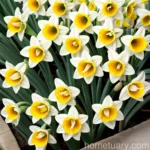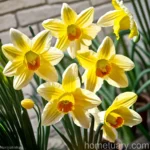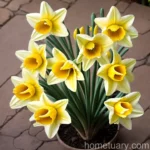The Trumpet Daffodil (Narcissus ‘Spellbinder’): A Complete Guide
What is a Trumpet Daffodil (Narcissus ‘Spellbinder’)?
The trumpet daffodil, scientifically known as Narcissus ‘Spellbinder’, is a stunning variety of daffodil that belongs to the Amaryllidaceae family. It is a unique and beautiful flowering plant that is cherished for its trumpet-shaped, golden yellow blooms and delightful fragrance. The ‘Spellbinder’ variety is a trumpet daffodil, which means it has a solitary, long, and tubular corolla (trumpet) that stands out amidst its flat, star-shaped petals. This variety is highly regarded for its elegance, making it a popular choice among gardeners and flower enthusiasts.
Key Takeaways – Trumpet Daffodil (Narcissus ‘Spellbinder’)
Before delving into a comprehensive guide on this enchanting plant, here are key takeaways to keep in mind:
Culture
- Common Name: Trumpet Daffodil ‘Spellbinder’
- Scientific Name: Narcissus ‘Spellbinder’
- Family: Amaryllidaceae
- Type: Bulb Flower
- Color: Golden Yellow
- Fragrance: Delightful, Sweet Scent
Uses
- Garden Ornamental Plant
- Cut Flower for Floral Arrangements
- Naturalizing in Landscapes
- Container Planting
Water
- Moderate Watering
- Well-Drained Soil
Sunlight
- Full Sun to Partial Shade
Fertilizer
- Balanced Fertilizer
Soil
- Well-Draining, Loamy Soil
- Slightly Acidic pH
Pruning
- Deadheading Faded Blooms
Propagation
- Division of Bulbs
- Offset Bulblets
Container Popularity
- Ideal for Container Gardening
Common Diseases
- Botrytis Rot
- Fusarium Wilt
- Basal Rot
Disease Diagnosis
- Yellowing Foliage
- Poor Growth and Blooming
- Dark Spots on Leaves
Common Pests
- Narcissus Bulb Fly
- Slugs and Snails
- Narcissus Eelworm
Botanist’s Tips
- Plant in Groups for Impact
- Provide Adequate Drainage
- Avoid Overcrowding
Fun Facts
- Symbol of Spring
- Mythologically Associated with Narcissus
- Attracts Butterflies and Pollinators
Links to External Resources
- Royal Horticultural Society – Narcissus ‘Spellbinder’
- American Daffodil Society
- The Daffodil Society
Now, let’s explore further into the intricacies of growing and caring for the mesmerizing trumpet daffodil, Narcissus ‘Spellbinder’.
Culture of the Trumpet Daffodil (Narcissus ‘Spellbinder’)
The culture of the trumpet daffodil ‘Spellbinder’ encompasses various aspects such as its water and sunlight requirements, fertilizer needs, soil preferences, as well as pruning and propagation techniques.
Water
Proper watering is essential for the health and vitality of the Narcissus ‘Spellbinder’. These daffodils appreciate moderate watering, especially during the growing season. However, it is crucial to ensure that the soil is well-drained to prevent waterlogging, which can lead to bulb and root rot.
- Watering Tips:
- Water deeply but infrequently, allowing the soil to dry slightly between watering to avoid waterlogged conditions.
- During extended dry periods, provide supplemental watering to support healthy growth and blooming.
Sunlight
Trumpt daffodil ‘Spellbinder’ thrives in locations with ample sunlight exposure. When selecting a planting site or positioning container-grown specimens, it is advisable to provide them with full sun to partial shade for optimal growth and flowering.
- Sunlight Guidelines:
- Plant in areas receiving at least 6 hours of direct sunlight.
- In warmer climates, partial shade during the hottest part of the day can help prevent excessive heat stress.
Fertilizer
To ensure robust growth and prolific blooming, it is recommended to fertilize trumpet daffodil ‘Spellbinder’ with a balanced fertilizer. Application of fertilizer should be carried out at specific times of the year to provide the necessary nutrients for healthy development.
- Fertilizer Recommendations:
- Apply a slow-release, balanced fertilizer in early spring before or during the emergence of foliage.
- Avoid excessive nitrogen, as it can promote lush foliage at the expense of flower production.
Soil
The composition and characteristics of the soil significantly influence the overall well-being of Narcissus ‘Spellbinder’. Ideally, these daffodils thrive in well-draining, loamy soil with a slightly acidic pH.
- Soil Preferences:
- Amend heavy or clay soils with organic matter to improve drainage and aeration.
- Maintain a slightly acidic soil pH in the range of 6.0 to 6.5 for optimal nutrient uptake.
Pruning
Proper pruning practices are vital for maintaining the appearance and vigor of trumpet daffodil ‘Spellbinder’. Deadheading, in particular, can promote continuous blooming and prevent seed formation, which can divert energy from bulb development.
- Pruning Techniques:
- Remove faded blooms by snipping the flower stalk at the base to enhance the plant’s appearance.
- Refrain from cutting back or removing foliage until it turns yellow and withers naturally, as it replenishes the bulb’s energy reserves.
Propagation
The propagation of Narcissus ‘Spellbinder’ is commonly achieved through division of bulbs and offsets. This process allows for the creation of new plantings and the expansion of existing clusters, leading to an abundance of charming blooms.
- Propagation Methods:
- Dividing bulbs during the dormant season is an effective way to propagate established plants.
- Harvesting and replanting offsets produced by mature bulbs can diversify and multiply planting locations.
Trumpet Daffodil (Narcissus ‘Spellbinder’) in Containers
The allure of growing trumpet daffodil ‘Spellbinder’ in containers has captured the interest of many gardening enthusiasts. The versatility and visual impact of container-grown specimens make them an attractive addition to various settings, from small balconies to expansive garden landscapes.
Container Popularity
The ‘Spellbinder’ variety is well-suited for container gardening, making it possible to enjoy the beauty of these daffodils in diverse settings. Containers offer the advantage of mobility, allowing for strategic placement and creating focal points in outdoor spaces.
- Benefits of Container Cultivation:
- Suitable for urban and space-limited environments where garden beds may be unavailable.
- Enables experimentation with design, allowing daffodils to be showcased in various containers and combinations.
Common Diseases and Pests Affecting Trumpet Daffodil (Narcissus ‘Spellbinder’)
While trumpet daffodil ‘Spellbinder’ is generally resilient, it is not immune to certain diseases and pests that can impact its growth and vitality. Understanding these potential challenges and their respective management strategies is essential for maintaining the health of these exquisite plants.
Common Diseases
Several diseases can affect the overall health and vigor of Narcissus ‘Spellbinder’, posing potential threats to its well-being. Being aware of common diseases and their symptoms can aid in early detection and appropriate intervention.
- Common Diseases:
- Botrytis Rot: Characterized by brown, water-soaked lesions on leaves and flowers, often promoted by high humidity and poorly ventilated conditions.
- Fusarium Wilt: Causing wilting, yellowing, and death of foliage, often associated with contaminated soil or planting material.
- Basal Rot: Manifests as soft, sunken areas at the base of the bulb, leading to decay and decline in plant health.
Disease Diagnosis
Timely identification of diseases affecting trumpet daffodil ‘Spellbinder’ is crucial for implementing suitable remedial measures. Key symptoms and signs can provide valuable insights into the nature of the issue and guide the appropriate course of action.
- Disease Identification:
- Yellowing Foliage: Indicates potential nutrient deficiencies, water stress, or presence of disease.
- Poor Growth and Blooming: Reflects underlying issues such as soil compaction, inadequate nutrition, or disease pressure.
- Dark Spots on Leaves: Often indicative of fungal infections, requiring prompt attention to prevent spread.
Common Pests
Various pests can pose a threat to the well-being of Narcissus ‘Spellbinder’, impacting its growth and flowering potential. Vigilance and proactive pest management approaches are necessary to mitigate the impact of these intruders.
- Common Pests:
- Narcissus Bulb Fly: Larvae of this fly feed on daffodil bulbs, leading to decay and reduced vitality.
- Slugs and Snails: These voracious feeders can cause extensive damage to foliage and flowers, particularly in damp conditions.
- Narcissus Eelworm: Small, microscopic worms that infest bulbs, causing distortions and decline in plant health.
Botanist’s Tips for Growing Narcissus ‘Spellbinder’
Incorporating botanist’s tips into the cultivation of trumpet daffodil ‘Spellbinder’ can enhance the overall success and enjoyment of growing these captivating plants. Valuable insights from experts in the field offer valuable guidance for a rewarding gardening experience.
Botanist’s Tips
- Plant in Groups for Impact: Create visually striking displays by planting Narcissus ‘Spellbinder’ in clusters or drifts, accentuating their enchanting blooms.
- Provide Adequate Drainage: Ensure proper soil drainage to prevent waterlogging, which can compromise bulb health and lead to disease issues.
- Avoid Overcrowding: Space bulbs appropriately during planting to promote air circulation and allow for individual growth and development.
Fun Facts about Trumpet Daffodil (Narcissus ‘Spellbinder’)
The trumpet daffodil ‘Spellbinder’ is not only a captivating ornamental plant but also possesses intriguing attributes and historical significance. Exploring the fascinating facets of this plant adds depth to the appreciation of its beauty and cultural relevance.
Fun Facts
- Symbol of Spring: Narcissus ‘Spellbinder’ symbolizes the arrival of spring, with its vibrant blooms heralding the end of winter and the renewal of nature.
- Mythologically Associated with Narcissus: The genus Narcissus is linked to the Greek myth of Narcissus, a figure renowned for his beauty and the origin of the term “narcissism”.
- Attracts Butterflies and Pollinators: The enchanting blooms of ‘Spellbinder’ have the ability to attract and support diverse pollinators, contributing to ecosystem biodiversity.
Conclusion
The trumpet daffodil ‘Spellbinder’, with its resplendent blooms and captivating fragrance, stands as a remarkable testament to the beauty and resilience of flowering plants. Appreciating its culture, care requirements, and enriching characteristics allows us to foster a deeper connection with nature and the art of gardening.
By embracing the botanist’s tips, understanding disease and pest management, and savoring the fun facts surrounding this delightful flower, we can embark on a journey of discovery and admiration for the enchanting trumpet daffodil ‘Spellbinder’.
References
- Royal Horticultural Society. “Narcissus ‘Spellbinder’.” Link
- American Daffodil Society. Link
- The Daffodil Society. Link
This blog post was written to provide a comprehensive guide and insights into the captivating world of the trumpet daffodil, Narcissus ‘Spellbinder’, with a detailed exploration of its culture, care, and botanical significance.















